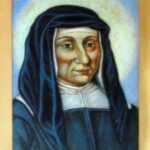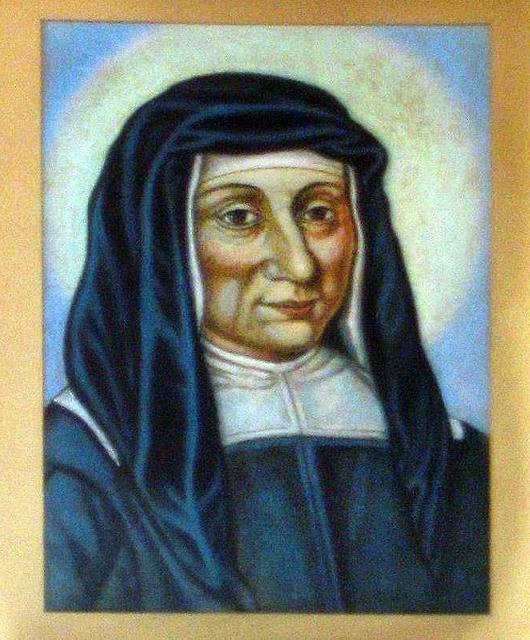 Robert Maloney CM writes… “Louise was a well-educated, cultured woman. She studied both French and Latin. She was read a lot, wrote well, eloquently at times, and had a subtle grasp of the theology of her era. She herself composed a catechism to help her sisters in teaching poor young girls. We still have the text today.
Robert Maloney CM writes… “Louise was a well-educated, cultured woman. She studied both French and Latin. She was read a lot, wrote well, eloquently at times, and had a subtle grasp of the theology of her era. She herself composed a catechism to help her sisters in teaching poor young girls. We still have the text today.
I am surprised that so little has been written about Louise as a painter. I don’t mean to say that she was a great artist, but her painting is surely an interesting facet of her personality.
We still have a number of her paintings. We know that there were many more. Louise called these “my way of amusing myself through images or other devotions” (ES 775).
Let me say a few words about each of these paintings.
We possess three watercolors done by Louise. The first depicts a young woman, representing Louise herself, seated by a river where there is a lovely view. Notice the towers in the building across the river, the trees, the flowers. The woman has just finished writing on a scroll the name of Jesus (which is upside down to the viewer). Louise has framed this scene with the words: “C’est le nom de Celui que j’aime” (It is the name of the one whom I love)”.
This painting is in the office of the Superior General at rue du Bac.
 This second watercolor shows the Good Shepherd surrounded by his sheep. One of them has climbed onto Jesus’ lap and is quenching his thirst at the wound in Jesus’ side. Two others seem to be doing the same at Jesus’ feet. A fourth appears to be about to kiss Jesus.
This second watercolor shows the Good Shepherd surrounded by his sheep. One of them has climbed onto Jesus’ lap and is quenching his thirst at the wound in Jesus’ side. Two others seem to be doing the same at Jesus’ feet. A fourth appears to be about to kiss Jesus.
Notice the background, which is quite detailed: the towers, a home, the fence, the river, a wall, the trees, birds, plants …
 This third watercolor is of the Holy Family. Joseph is working as a carpenter, with the child Jesus watching and learning. Mary seems to be mending clothes. Notice the tools, the lumber, the wood scrapings on the ground, the house, the windows, the door, the paved terrace, the birds, the landscape, the trees …
This third watercolor is of the Holy Family. Joseph is working as a carpenter, with the child Jesus watching and learning. Mary seems to be mending clothes. Notice the tools, the lumber, the wood scrapings on the ground, the house, the windows, the door, the paved terrace, the birds, the landscape, the trees …
 Here is a much larger rendition of the Holy Family. This painting dates from the foundation of the first house of the Daughters of Charity in the Parish of St. Savior. When the house closed, the painting came to the Maison-Mère.
Here is a much larger rendition of the Holy Family. This painting dates from the foundation of the first house of the Daughters of Charity in the Parish of St. Savior. When the house closed, the painting came to the Maison-Mère.
Mary and Joseph are standing, or perhaps walking, with Jesus, upon whom the Holy Spirit is descending. Joseph is adorned with the traditional lilies. Mary seems to be praying.
This medallion is in the Archives at rue du Bac and was formerly in the apartment of the Mother General. On the reverse side, as we shall see, is an attestation that it was painted by St. Louise.
A close photographic analysis of the painting showed a heart that the naked eye could barely see and that had gone unnoticed for years.
On the right banner near the head of Christ are written the words: “Learn from me that I am gentle …”, and on the left banner: “Come, blessed of my Father …”
It was to images like this that St. Louise was referring when she wrote to a sister, saying (ES 334): “Here are some images that I am sending you: a Lord of Charity to put in the room where you receive the poor and another for your own room.”
As you can see clearly, there is an attestation on the reverse side of the medallion stating: “Cet image a été peint de la propre main de la venerable Louise de Marillac, veuve de M. le Gras, secretaire de la reine Marie de Medicis, et 1ere Supérieure de la Compagnie. Morte le 15 mars 1660 (This image was painted by the very hand of the venerable Louise de Marillac, widow of Monsieur le Gras, secretary of the queen Marie de Medicis, and first Superioress of the Company. Died, March 15, 1660)”.
 This painting is on the staircase near the office of the Superior General in the Maison-Mère of the Daughters of Charity on rue du Bac. St. Vincent and St. Louise distributed similar images, which they called the “Lord of Charity”. Vincent sent Louise the first such printed image, painted by an unknown artist, in January of 1640 (SV II, 10). Louise sent out a number of these images to the houses of the Daughters (cf. Ecrits Spirituel, 223, 334).
This painting is on the staircase near the office of the Superior General in the Maison-Mère of the Daughters of Charity on rue du Bac. St. Vincent and St. Louise distributed similar images, which they called the “Lord of Charity”. Vincent sent Louise the first such printed image, painted by an unknown artist, in January of 1640 (SV II, 10). Louise sent out a number of these images to the houses of the Daughters (cf. Ecrits Spirituel, 223, 334).
At the bottom of this painting someone has written in capitals: “Ce tableau a été peint par Mlle Le Gras notre mère et institutrice (This tableau was painted by Mademoiselle Le Gras, our mother and founder)”. In 1891 this painting was noticed in a chapel annexed to the cathedral of Cahors, where a house of the Daughters of Charity had been established in the time of St. Vincent and St. Louise. It is likely that this house, like many others (as we know from the writings of St. Louise), received a “Lord of Charity” painted by her. Such paintings were probably placed in the room or chapel where the Confraternities of the Ladies of Charity met, so that they might have an image of the Lord, their patron. It appears that, for some reason, the sisters in Cahors had a local artist add 25 centimeters of canvas around the painting, harmonizing the new canvas with the original painting and adding the inscription. The painting probably was sent to the chapel at the cathedral during the French Revolution when the sisters were expelled from the orphanage they ran in Cahors. In 1891, a member of the Conferences of St. Vincent de Paul drew it to the attention of a confrere, M. Méout, who was the superior of the major seminary there. The bishop of Cahors gave it to the Daughters at the Maison-Mère.
The painting shows Jesus, almost life-size, with open arms, his head inclined and his eyes lowered as if he were speaking, and offering his love to, a Christian who is imploring him. He is standing on a globe to signify that he is both its creator and its savior. His feet and hands show his wounds. His heart radiates rays of light.
This is really a remarkable image, if one considers that it was painted 50 to 60 years before St. Margaret Mary’s visions of the Sacred Heart. Louise’s devotion to the heart of Jesus probably has roots in the influence of St. Francis de Sales on her spirituality and in her contacts with the Capuchin sisters and with the Visitation sisters, who at that precise time were fostering devotion toward the sufferings and the five wounds of Christ. The heart that Louise paints is simpler that the one that Margaret Mary later popularized. It is without a flame. There is no crown of thorns. But it is one of the first such representations of the heart of Jesus that we know of. Some feel that the heart in this painting was added, but most likely it comes from the hand of St. Louise herself. It is interesting to note that St. Louise placed the heart of Christ on the seal of the Daughters of Charity too.
Online sources
- http://famvin.org/en/2009/01/06/lesser-known-qualities-of-vincentian-saints/
- http://www.vincenziani.com/CONFERENZAMALONEY.htm
- http://vincentians.com/blog/some-lesser-known-human-qualities-of-the-saints-of-the-vincentian-family/
Tags: Louise de Marillac





Very interesting. As far as I know, this is the first time anything focusing on Louise as a painter has appeared. She also did small pictures on the same themes that she gave to individual sisters. Painting was certainly an important part of her life. Thank you for pointing that out for us.
SO well done!
Thank you..
St Louise loved her painting and to share that is sharing part of her!
AMEN
As an artist I’m grateful for your sharing
St. Louise’s paintings. This is encouraging
for others with this talent
Some of these paintings can also be found at http://stvincentimages.cdm.depaul.edu/?lib=St.%20Louise%20De%20Marillac&path=St+Louise+De+Marillac%2FLouise+miscellaneous . The computer images are of a slightly higher quality so you can see more detail than the ones shown here.
Thank you very much for exposing these paintings of St. Louise. I had never seen these ones except for the one of the Lord of Charity.
They are very detailed leading to in-depth reflection. In spite of her heavy schedule she found time to express her reflections and feelings in painting…